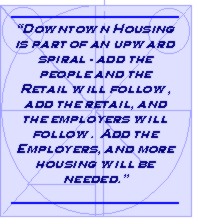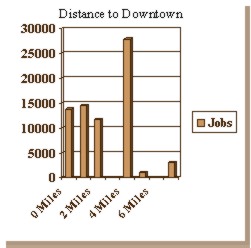NM APARTMENT
1 9 8 9
REPORT
1 9 9 8


"DOWNTOWN PART 2 - REVIVAL COMING OF URBAN LIVING"
Originally appeared inNew Mexico Apartment Report Vol. 5.2 - Q2’98
Albuquerque Mayor Jim Baca's goal of building 500 housing units Downtown in the next four years is getting off to a fast start with plans currently moving on about 250 units.
The biggest single project involves about three acres on the north side of Coal Avenue, between Fifth and Eighth streets. Albuquerque Development Services issued a request for proposal to develop the property for higher-density, multifamily housing two weeks ago.
"There's been a great deal of interest," said Doug Chaplin, housing development coordinator at Development Services. "There's been at least a dozen requests for development packages to be sent out." (deadline for this project is June 2, 1998)
In addition, a Santa Fe joint venture hopes to break ground this summer on a 13-unit, mixed-housing project on the south side of Coal, between Fifth and Sixth streets. The units - six bungalows and seven townhouses - would be owner occupied.
Plans are in the final stage of city approval for the seven-unit reconstruction of Anson Flats Apartments, Victorian rowhouses at the northwest corner of Fifth and Marble Streets.
Redevelopment services is currently in negotiations with a developer to build 30- to 40-apartment units on about a half acre at the northwest corner of Coal and Fourth.
The four projects, which could add up to around 250 units, are the first new multifamily housing initiatives in Downtown to get off the ground since the 210-unit Alvarado Apartments were built in 1984 on Lead Avenue, between Sixth and Eighth.
The biggest city-driven redevelopment project in Downtown, however, is centered around the Alvarado Inter-Modal Transportation Center, which is expected to go out to bid in six months. The city has been acquiring property in the vicinity of the transportation center site at Lead Avenue and Second Street.
Last week, out-of-town urban planners were being hosted by the city to assess the potential of the property. "Their specialty is mixed-use development and it'll be interesting to see what their perspective is," said Ken Balazar, director of development services. "I could really see as part of that mixed-use development a couple hundred housing units within the next four years."
Downtown Albuquerque has nebulous boundaries, but an October 1995 survey of business and property owners defined its boundaries as Lomas Boulevard to the north and Coal Avenue to the south; Broadway Boulevard to the east and, with the least amount of agreement, Eighth Street to the west. The survey was commissioned by the then-Center City Council.
The boundaries are likely to expand north with the opening of the $50.4 million federal building currently under construction on the north side of Lomas, between Third and Fourth streets. Likewise, the eastern boundary may expand with the proposed renovation of the old Albuquerque High School on the east side of Broadway, between Central Avenue and Martin Luther King Boulevard.
Development Services has requested new RFPs due May 11 from two private-sector finalists for the project: Farmont of Phoenix in partnership with Design Collaborative Southwest (one of eight original bidders on the project last year), and Austin-based Paradigm.
And on the south side of Downtown, the planned 150,000-square-foot, $15 million Social Services Administration call center on the south side of Lead, between Fifth and Sixth, is a driving factor in the city's multi-family housing initiative.
Development of housing in Downtown is part of the agreement between the city and federal General Services Administration to relocate the call center from leased space in the Airport area. Although Albuquerque Development Services was already working on smaller housing initiatives, Chaplin said the agreement "forced some time frames to work within as a starting point and goal."
The biggest impact was speeding up the RFP issued two weeks ago for multifamily housing on three acres on Coal between Fifth and Eighth. Part of the project area abuts the planned four- to five-story call center. Key elements of the RFP include the time frame of starting construction this year with units ready to rent in December 1999. Another key is the density range of 40 to 60 units per acre. The RFP says, "A higher density is supported by the market study provided with the developer's proposal packet." The half-inch-thick market study was prepared by Todd Clarke, an investment broker and consultant at Grubb & Ellis/Lewinger Hamilton Inc. Clarke analyzed the impact of different densities on the developer's profitability with such a project.
At the low end of the RFP's density range - 40 units per acre - the proposed apartments would have 128 units and cost about $6.8 million. According to Clarke's analysis, however, the developer would show a loss of about $220,000 on the project.
At the high end of the RFP's density range - 60 units per acre - the proposed apartment community would have 192 units in a variety of buildings, including one four-story tower. The total cost would be about $11 million, with a profit in the $700,000 range for the developer.
In his market study, Clarke based the cost on the land priced at $4 per square foot. The RFP is based on a lower land price of $3 per square foot. On the other hand, the study indicates the analysis of the 192-unit alternative underestimated the construction cost of the four-story tower. For perspective, Clarke told NMBW that land costs in Downtown range from $4 to $28 per square foot. The average cost for land zoned for apartments is currently $3.91 per square foot in the metropolitan area.
Indeed, comparatively-high land prices in Downtown have discouraged investment in redevelopment. Land is simply cheaper on the fringe of the metro area.
"When I think of redevelopment Downtown, I think of risk - the cost of land and parking," Balazar said. "In an urban area, that's the challenge."
The city's foremost inducement to redevelopment is to buy the land, then offer it at a below-market price to developers. Other incentives which are being looked at include a waiver to the city's utility expansion fee and fast-tracking redevelopment proposals through the approval process.
The parking issue is trickier. "It's a policy decision. Do we park Downtown or develop an efficient shuttle system," said Chaplin. Balazar added, "It's likely to be a combination of the two." Balazar said three areas have been identified as in need of parking structures: the planned Social Security Administration call center, new federal courthouse and inter-modal transportation center.
The first housing redevelopment project to get underway is probably going to be 13 units on the south side of Coal between Fifth and Sixth. The project is a joint venture involving Santa Fe-based Zydeco, the real estate and development division of Yates Drilling Co.
"We're ready to go as soon as we have a contract. We have to rezone the property because we've changed lot sizes," said Zydeco's Doug Brown. "We'd like to begin this summer."
Housing redevelopment on Coal Avenue is not expected to run into opposition from nearby property owners, which is the bane of apartment proposals.
The city published a 23-page booklet, Coal Avenue Design Guidelines, in May 1997. The booklet was a collaborative effort by an ad hoc committee composed of architects, city officials, members of Downtown business groups and a representative from the Barelas Neighborhood Association.
The booklet of guidelines and Clarke's market study are two steps done by development services to calm what Balizer described as the "risk-adverse reflex" in developers. The goal is to get action. "I think as soon as we have some successful projects, we'll see a difference," Balizer said. "I've already seen more interest in the past couple months."
Additional News - Downtown Update
Our initial consulting contract for downtown housing has been completed. The city has given the nod to two developers on the townhouse site and a smaller apartment site. The city is looking for developer response on the prime site for 150 to 200 units by June 2, 1998. Please Doug Chaplin at the Metropolitan Redevelopment Agency (764-0037) for an RFP booklet.
Downtown Neighborhood Association lobbies the city council to consider adding parking structures to handle the new courthouse construction, while eliminating the ability for most homeowners to demolish their home for a parking lot.
Dissention in the troops – although the Albuquerque Journal protrays several power hungry groups are jockeying for lead position in downtown affairts, the reality is that the more people who are interested in downtown’s growth, business development and housing needs, the better off we are as a city. Look for more downtown promition to occur in the near future.
Old Albuquerque High School – as a member of one of the two competing groups, it would be premature of me to let any secrets out of the bag prior to the August 1998 final selection deadline. What I can tell you now is that at least one of the groups has developed a strong plan for a mixed use product, that combines the interests of the city, neighborhood and alumni, while minimizing the cost to the City. The other group would like to have the taxpayers “subsidize” AHS for the next 30 years, to the tune of several million a year (any guesses which team I am on?)
Bernalillo County plans a new courthouse - construction is set to begin this fall on a new 248,500 square foot county court house at Lomas between Fourth and Fifth Streets (near the new Federal Court house). The total estimated construction costs are $50M. The County Commission recently voted to name the building after the late New Mexico Congressman Steven Schiff.
Up to date info on downtown happenings can also be found at our website http://www.nmcomreal.com/nmcomreal.
Article by
by Todd Clarke CCIM (www.nmcomreal.com/nmcomreal)
p a g e
o n e
